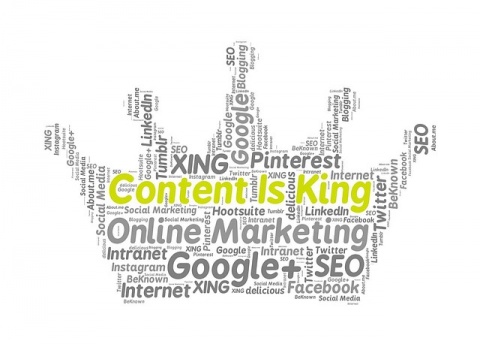By the end of 2016, 60% of businesses will have appointed an executive who is directly responsible for the company’s content strategy. Additionally, "76% of B2B marketers say they plan to increase the amount of content they produce in 2016 compared to 2015". These statistics all point to the same thing: when done right, content marketing works.
Of course, “when done right” is a pretty big caveat when asking businesses to invest their time and energy in a marketing campaign, especially when talking about a field as crowded as online content. To make things even more difficult, there’s no one true path to success with content marketing – a technique that works for one company may fizzle when another company tries to copy it. However, there is a basic strategy that should be the starting point for planning a content marketing campaign, regardless of the business it’s for or the audience being targeted.
What is Content Marketing?
Let’s start with the most obvious question: what is content marketing? The simple definition is “the use of engaging online content to raise brand visibility and drive web traffic.” Once you start trying to put content marketing into action, however, the answer isn’t so straightforward. The first issue that rears its head is that there are many different types of online content: blogging, YouTube videos, sponsored articles, online press releases, social media, slideshows, and email marketing, just to name a few. Producing all of these types of content takes work, time, and resources, which means that any content marketing campaign will have to focus on using only some types of content. This leads to another question, one that takes effort to answer: how do you choose what types of online content to focus on?
There are other questions that have to be answered as well:
- How much content needs to be produced?
- Where should it be posted?
- How can you be sure the content is reaching the target audience?
Creating an effective content marketing campaign requires answering all of these questions, most of which don’t have obvious, objectively correct answers. The good news is that answering one of these questions in particular makes finding the answers to the rest much easier.
What is Your Content Marketing Goal?
Of all the questions about content marketing that need to be asked, “What goal is our content marketing meant to achieve?” is the most important.
Launching a content marketing campaign without having a firm goal in mind is probably the biggest mistake one can make. It’s also one of the most common. As part of their research into how businesses create and use online content, the Content Marketing Institute asked professional B2B marketers how they determined whether their content marketing efforts were successful. In response, 55% said that their organizations didn’t know what it meant for a content marketing campaign to be a success.
Statistics like this point out an unfortunate attitude many people have about online content. For many, online content is something created out of a sense obligation, rather than something used to achieve a definable goal. Many companies only have blogs, YouTube pages, and Google+ pages because their competitors do, or because they heard somewhere that they were supposed to have them. When businesses approach content marketing in this way, it inevitably leads them to create aimless content campaigns that usually end up being a waste of time and resources. When content is created with a specific goal in mind, on the other hand, it can be an incredibly effective marketing tool that can be used achieve a number of important goals.
As such, the first step to planning a content marketing campaign should be to decide what your immediate goals are. Driving web traffic, increasing social media followers/blog subscribers, generating sales leads, and improving search engine placement under key search terms are all common goals that content marketing can be especially effective at achieving. In addition to helping narrow down the scope of content that needs to be produced, having a firm goal in mind also allows you to track the campaign’s performance and determine whether or not the current strategy is worth the investment of time and energy.

The Right Tool for the Job
Once you’ve decided on a goal for your content marketing campaign, the next question that needs to be asked is, “What is the best way to achieve this goal?” Answering this question requires taking into account who your audience is, and what actions you want to inspire that audience to take. Once this has been determined, the next step is to decide what kind of content is most likely to reach the intended audience.
When it comes to content marketing, form follows function. There are many different kinds of online content, and every form, from slideshows to long-form articles, has strengths and weaknesses as marketing material. When you know what you want to achieve with your content marketing, choosing the type of content to focus on creating becomes much easier.
For Example
Let’s say your current content marketing goal is to increase the number of followers you have on social media. In that case, your efforts should focus on creating the kind of online content that social media users like to read and share with their followers. If you’re a B2B company attempting to generate new sales leads by marketing your services directly to other businesses in a niche industry, a focus on creating press releases, white papers, and other content that will attract the attention of industry insiders is going to be more effective than trying to create viral posts on Facebook.
Once you’ve settled on a goal, the next step is to set some hard numbers you want to achieve (number of new subscribers, a percentile increase in sales leads, etc.) and a reasonable timeframe during which you think that goal can be achieved. As long as you’ve set a reasonable goal (chances are you won’t be getting a million Facebook followers in a single month), measuring the results of your content marketing campaign against your original expectations will provide a good indicator of how your content marketing strategy is working. If you aren’t seeing the results you expected, try altering your strategy.
Let’s say your content marketing goal is to increase the number of readers for your blog page. To achieve this, you decide to produce a weekly series of blog posts, which you will link on your Facebook account. You set a goal of increasing web traffic by 50% at the end of six months. Three months in, you haven’t seen any noticeable increase in web traffic. At this point, it’s time to consider changing up the strategy. The changes can be as simple as increasing the number of times you share links on Facebook, or linking blog posts on additional sites in order to reach an even larger reader base.
"When it comes to content marketing, form follows function."
A Few Content Creation Tips
Regardless of what direction you decide to take, there are a few guidelines that should be followed to create the most effective content possible:
Keep your promises
Every piece of content makes an initial promise to the reader. A white paper titled “Important Trends in the Medical Devices Industry for 2016” needs to actually discuss trends that are important to the medical devices industry, and back any claims it makes up with real numbers. Likewise, a blog post about “6 Things You Need to Know Before Remodeling Your Home” needs to contain information that’s actually useful to people looking into home remodeling. A lot of online content promises more than it delivers, or operates on the premise that all that matters is a catchy title that will grab people’s attention. This kind of thinking greatly underestimates the audience’s intelligence, and its patience. Most content marketing goals require gaining the trust of the audience or impressing them with your knowledge and insight. Once your audience starts to associate your brand with vapid clickbait, they no longer trust your content or your business.
Engage with your audience
The main goal of content marketing is to attract an audience. Creating online content is only the first part of that process. Once your content starts to attract an audience, it’s a good idea to interact with them and encourage them to keep following. When someone responds to your content, such as leaving a comment or sending an email asking for more information, it’s important to respond to their queries as quickly as possible. This kind of interaction helps build brand loyalty by giving the audience positive reinforcement to continue liking, sharing, and subscribing to your content.
Use sharing buttons
In order for your content to reach as wide an audience as possible, it needs to be as easy to share as possible. One of the easiest ways to make sure your content gets spread around is to include sharing buttons for social media sites like Facebook, Twitter, and Reddit, and to include convenient links for sharing your content across different platforms. Many platforms automatically include sharing buttons, or have them as optional add-ons. If the platform you’re using doesn’t include sharing buttons, make sure to post links on social media and other sites that do have easy sharing capabilities.
If you go into content marketing expecting instant success on a grand scale, you’re going to come away disappointed. If, however, you approach it with an achievable goal, a strategy for achieving it, and an open mind that lets you react to situations as they arise, content marketing is a powerful tool with the potential to help businesses reach new levels of success.

